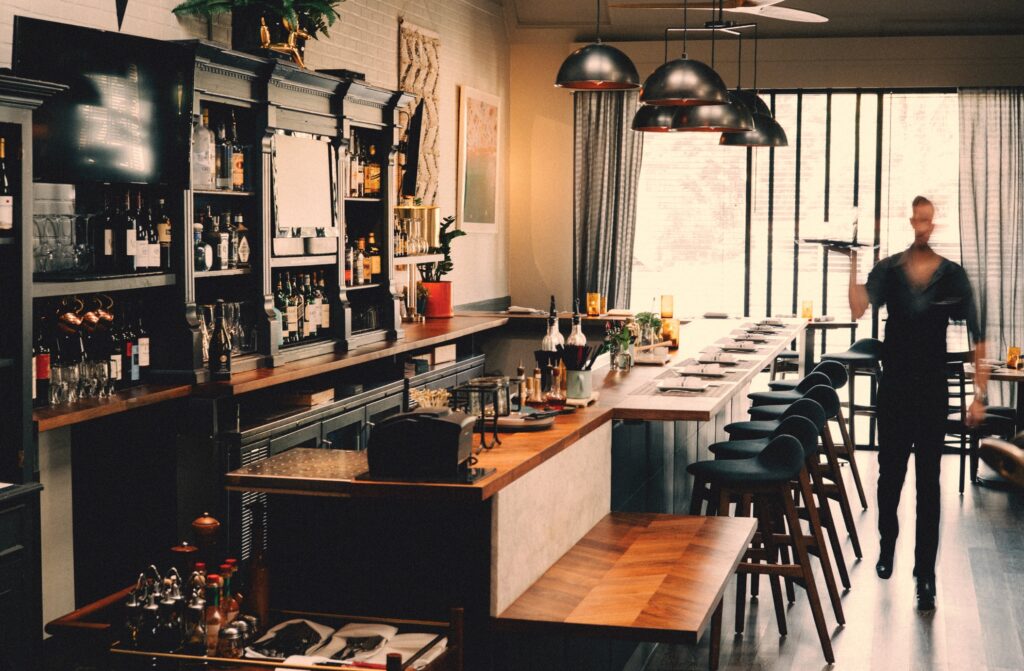Exit, Stage Left
Posted by estiator at 13 December, at 09 : 21 AM Print
COVER STORY By Constantine Kolitsas
Selling your restaurant in the post-Covid era.

Once upon a time, a restaurant owner could look at their business as an investment, with the notion that at some point in time, they could cash out, selling to a young, eager buyer for a handsome profit upon which they could retire. The paradigm has shifted, however, as a confluence of contributing factors conspire to derail the golden parachute that many once dreamed possible.
Many of those contributing factors have, of course, been in the making for years, among which are demographic shifts, access to affordable labor, and deteriorating margins. On that last point alone, much is to be said of the natural laws of economics and capitalism: that capital looks to generate more capital in the most cost-effective and restriction-free manner possible. That sounds nothing like the reality facing restaurateurs today, or, to be truthful, ever in the history of the industry.
To set the stage, let’s accept the fact that once you peel away the industry’s sex appeal (too many investor fools have been wooed by the luster that a trendy restaurant can attach to their public persona and have, hence, been quickly parted from their money, as the adage goes), there is no rational reason to enter into the restaurant industry unless it’s your only path toward wealth. This much is certainly true of the industry’s pioneers, most of whom arrived as immigrants to these shores and found that with a little talent, lots of hard work, and some luck, they could create quite a bit of wealth for themselves. Sure, it meant working 70-hour weeks, but we are primarily talking about economic refugees, such as the Greeks who arrived in the 1950s, having left a nation and an economy ravaged by a Nazi occupation succeeded by a vicious civil war. For that particular generation, however, once they figured out the formula, keeping the money flowing in was never an issue.
Flash-forward to today, to an economy struggling to shrug off the impact of a global pandemic, still uncertain if the economic cure is worse than the ailment itself. And if the cure doesn’t kill us, it’s uncertain if the side effects will. Let’s pause for a moment and look at those side effects. Worker apathy has never been higher. Talk to any restaurant owner or manager and they’ll be quick to attest that today’s generation of restaurant worker just doesn’t care that much. Confident that they can secure a better job within minutes, there is no impetus for them to perform their work to the best of their abilities. With the fear of losing a secure job removed, managers are getting less and less from their workers, while at the same time having to pay more and more. Where a line cook five years ago in the metropolitan areas of the northeast earned $12 per hour and was happy to pick up five hours of overtime, today’s line cook demands upwards of $20 per hour with 15 to 20 hours of overtime. Other side effects of the pandemic are a result of rapidly escalating prices. With consumers getting pinched on everything from energy to grocery store purchases, restaurateurs are hesitant to raise prices in tandem with rising costs for fear that they’ll be faced with empty dining rooms.
At this point, you’re asking, “So, where does selling a restaurant come in?” And the answer is, we have to understand what it is we’re selling before we can under- stand how difficult, at what valuation and to whom we can sell our restaurants. And for this, we turned to two individuals who have made careers selling restaurants.
Tony Sereslis has been in commercial real estate for over five decades. Active primarily in the Connecticut, Massachusetts, and Rhode Island markets, he estimates that he has sold over 2,000 businesses in that time.
“Are you a serious buyer?” These are the first words to come from his mouth when he returns a call (he always returns calls) left on his voicemail inquiring about a business he has listed in one of the websites where prospective buyers surf for opportune purchases. Not surprisingly, the next words from his mouth are: “Do you have the money to finance the purchase?” (“I ask how much they have for a down payment,” he says, “and this gets some people upset. Many people think that they could put 5 or 10 per- cent down, which is not realistic.”)

Tony is a no-BS individual, and he takes a strong no-BS approach to selling. He’s certainly earned those rights, and his approach serves his clients well. He has no time to entertain fishing expeditions or to stroke vanities. He’s put together countless deals that have made millionaires of line cooks and dishwashers.
Our conversation starts with the impact that Covid-19 had on the restaurants in his market. “Since Covid, I have sold fewer restaurants than in the previous years because the virus brought business down, in some cases by half,” says Sereslis.
The difficulty of finding qualified buyers is compounded by the fact that most restaurant workers today are making a handsome living without the headaches of business ownership.” – Tony Sereslis
“The market is very confused and for many reasons,” he says. “Before the pandemic, things were a little normal. After the pandemic, things got worse and very confused because many people were selling restaurants at very low prices compared to four or five years ago. “Going back to those contributing factors mentioned earlier, Sereslis places a significant blame on deteriorating margins. “Today’s restaurant operators are not enjoying normal margins,” he says. “We no longer live in a normal universe.”
And of course, there is the demographic shift previously mentioned. “Years ago, the majority of restaurant buyers were Greeks and Italians,” says Sereslis. “Today, the majority are Albanians, Indians, Mexicans, Arabs, some Chinese. This has created a new atmosphere. Many are first-time business owners and have no idea about business. Some have money, but without expertise in business, many buy a place and lose it five or six months later. Others keep trying and eventually figure it out.”
“Lately I get many calls from investors—doctors, lawyers, etc.—all within the ethnic communities,” he continues. “These people have some money, and they put it in the bank and think it’s easy to buy some restaurants and put their friends in to run them and then go and collect money every week. But too many times, they are putting people in who don’t know what they are doing.”
Years back, he says, those investors were not part of the market. The situation makes it difficult. “I have an individual who wants to purchase a restaurant,” he says. “This individual has $200,000 to spend but can’t speak English. I have a hard time selling a business to someone who I don’t believe will succeed. When they lose the place, they will blame every- one for the failure—the lawyers, the real estate broker, everyone.”
The difficulty of finding qualified buyers, says Sereslis, is compounded by the fact that most restaurant workers today are making a handsome living without the head- aches of business owner- ship. “Today, most people don’t want small places,” he says. “They are already making $60,000 to $70,000 a year, and they don’t want to take over small places just to make a few dollars more.”
But there are more than ethnodemographics at play, he says. The pandemic has brought people from the urban centers to more rural locations. “Many people opening restaurants are leaving New York and coming to Connecticut,” he says. “And it’s also true that the rents are cheaper in Connecticut than in New York, New Jersey, and Pennsylvania,” he says.
To the genre of eatery most in demand from a purchase standpoint, Sereslis indicates that higher-margin businesses seem to be selling more quickly. “Good places that were making good money in the past but have suffered since the pandemic are getting stuck,” he says. “For example, diners are a problem. The diners in Connecticut have been around for many years. Profits are lower than what they had been in the past. Some families have been in the business for 60 years, and many are for sale,” he adds. “But today’s buyers are looking for operations that are easier to run.”
Valuations on businesses that are selling, Sereslis says, are highest for businesses with a demonstrated profit, rather than sheer revenue levels. “I recently sold a restaurant that was making about $26,000 in weekly sales for about $370,000. Another that was making just a little more was sold for $480,000, but it was because it was more profitable.”
The segment that was hurt the most (in New Jersey) were the BYOB operations with leases in shopping centers that couldn’t pivot with outdoor dining. The full-service, free-standing properties are selling now back to pre-pandemic values.” – Tim Delaney
What doesn’t sell, he says, is potential. “Buyers are not paying a premium for potential. They are looking at the numbers to make their decisions.”
But that’s not to say that all hope is lost.
“There is a buyer for every restaurant,” he says. “You just have to find the right person.”
Tim Delaney has been selling restaurants in New Jersey, eastern Pennsylvania, and Rockland County, New York, since 1997. He indicates that 2022 will be a very good year for his business, in which he typically closes on between 15 and 20 locations each year.
“Our customers are mostly seasoned multi-unit real estate buyers who are experienced and want liquor licenses—which in New Jersey is a very expensive proposition,” he says.
During Covid, he says that pizzerias “sold like crazy” while today he sees a more even playing field in the types of restaurants sold. “The locations that need renovations, updating, and rebranding are not moving,” he says. “No one wants to do the construction” or make costly investments in equipment. “It’s still very hard to get construction products and new equipment. I wouldn’t recommend an older restaurant owner renovating to sell. Take what you can get, and wish the next owner luck.”
Key to making a sale, he says, is that a restaurant is priced correctly, with many buyers taking the SBA funding route.
“The segment that was hurt the most (in New Jersey) were the BYOB operations with leases in shopping centers that couldn’t pivot with outdoor dining,” he says. “The full-service, free-standing properties are selling now back to pre-pandemic values.”
Canvassing the landscape, however, Delaney believes that it is still a buyer’s market. “So many owners/sellers are so exhausted from Covid that they’re done with the industry,” he says.
When “restaurant shopping,” he feels that buyers are looking mostly for places that can do at least $50,000 per week in sales, or fast-casual grab-and-go as well as catering operations with no services.














